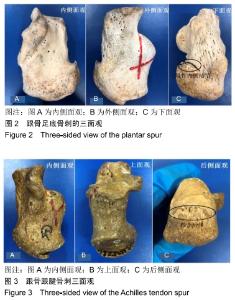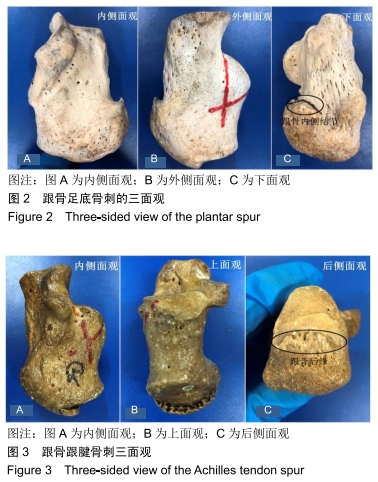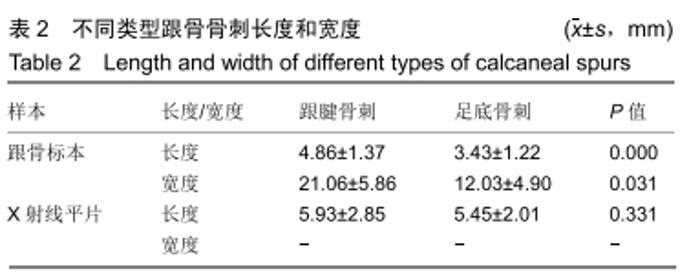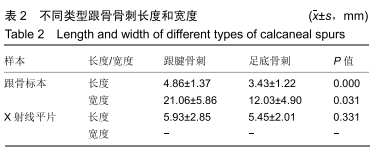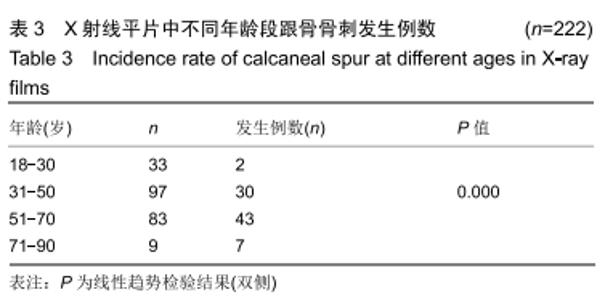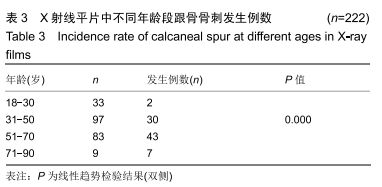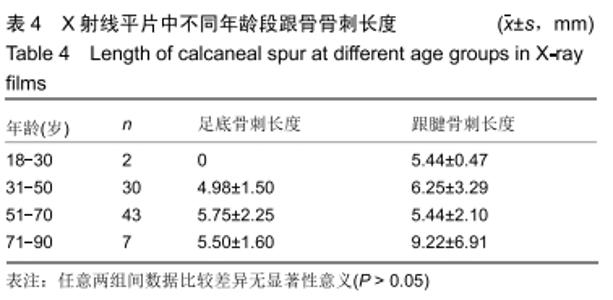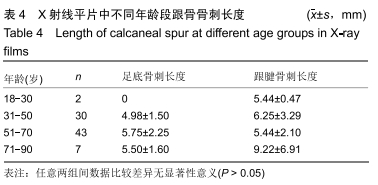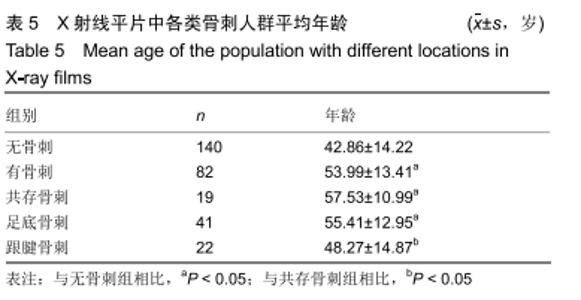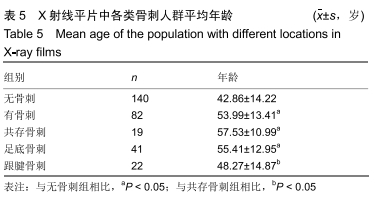[1] KUYUCU E, KOÇYIĞIT F, ERDIL M. The association of calcaneal spur length and clinical and functional parameters in plantar fasciitis.Int J Surg. 2015;21:28-31.
[2] KIRKPATRICK J, YASSAIE O, MIRJALILI SA .The plantar calcaneal spur: a review of anatomy, histology, etiology and key associations.J Anat. 2017;230(6):743-751.
[3] TU P. Heel pain: diagnosis and management.Am Fam Physician.2018; 97(2):86-93.
[4] 叶永亮,霍力为,罗曼,等.跟痛症相关的解剖学研究[J].中医正骨,2019, 31(2):1-4.
[5] 马显志,陈兆军.跟痛症治疗进展[J].中国骨与关节外科,2012,5(4): 373-376.
[6] MORONEY PJ, O’NEILL BJ, KHAN-BHAMBRO K, et al. Theconundrum of calcaneal spurs: do they matter?. Foot Ankle.2008;7(9):95-101.
[7] FRANSON J. Some New Ideas in the Treatment of Retro Calcaneal Exostosis.Foot & Ankle Specialist. 2008;1(5): 309-311.
[8] BENJAMIN M, TOUMI H, RALPHS JR, et al. Where tendons and ligaments meet bone: attachment sites (‘entheses’) in relation to exercise and/or mechanical load.J Anat. 2006;208(4):471-490.
[9] ZHOU B, ZHOU Y, TAO X, et al.Classification of Calcaneal Spurs and Their Relationship With Plantar Fasciitis.J Foot Ankle Surg. 2015;54(4): 594-600.
[10] MORONEY PJ, O"NEILL BJ, KHAN-BHAMBRO K, et al.The Conundrum of Calcaneal Spurs: Do They Matter?. Foot Ankle Spec. 2014;7(2):95-101.
[11] JOHAL KS, MILNER SA.Plantar fasciitis and the calcaneal spur: fact or fiction?.Foot Ankle Surg. 2012;18(1): 39-41.
[12] BERGMANN JN.History and mechanical control of heel spur pain.Clin Podiatr Med Surg.1990;7(2): 243-259.
[13] MENZ HB, ZAMMIT GV, LANDORF KB, et al. Plantar calcaneal spurs in older people: longitudinal traction or vertical compression?.J Foot Ankle Res. 2008;1(1):7.
[14] BEYTEMÜR O, ÖNCÜ M.The age dependent change in the incidence of calcaneal spur.Acta Orthop Traumatol Turc.2018;2(5): 367-371.
[15] TOUMI H, DAVIES R, MAZOR M, et al. Changes in prevalence of calcaneal spurs in men & women: a random population from a trauma clinic.BMC Musculoskelet Disord. 2014;15:87.
[16] 张庆,张宁,虞泽伟,等.跟骨骨刺的临床特征及其影像学参数与发病的相关性研究[J].中华创伤骨科杂志, 2016,18(6):487-492.
[17] 栗平,王兴国,王东海,等.超声剪切波弹性成像及多模态成像技术分析足底跖腱膜的解剖结构特征[J].中国组织工程研究, 2018,22(11): 1756-1761.
[18] ABREU MR, CHUNG CB, MENDES L, et al.Plantar calcaneal enthesophytes: new observations regarding sites of origin based on radiographic, MR imaging, anatomic, and paleopathologic analysis. Skeletal Radiol. 2003;32(1):13-21.
[19] SINGH R, ROHILLA R, SIWACH RC, et al.Diagnostic significance of radiologic measurements in posterior heel pain.The Foot.2008;18(2): 91-98.
[20] YUNG-HUI L, WEI-HSIEN H. Effects of shoe inserts and heel height on foot pressure, impact force, and perceived comfort during walking. Appl Ergon.2005;36(3): 355-362.
[21] 吴立军,丁自海,钟世镇,等.足弓第2与第5跖列的肌骨系统有限元模型及其临床意义[J].中国临床解剖学杂志, 2006,6(11):691-694.
[22] 陈华佑,麻吉元,潘丽雅,等.足底腱膜的解剖[J].解剖学报,2017,48(5): 561-564.
[23] MIRZAALI MJ, SCHWIEDRZIK JJ, THAIWICHAI S, et al.Mechanical properties of cortical bone and their relationships with age, gender, composition and microindentation properties in the elderly.Bone.2016; 93(12):196-211.
[24] DHAHIR BM, HAMEED IH, JABER AR. Prospective and retrospective study of fractures according to trauma mechanism and type of bone fracture.Res J Pharm Technol.2017;10(11): 1994-2002.
[25] TALIC G, TALIC L, STEVANOVICPAPICA D, et al.The effect of adolescent idiopathic scoliosis on the occurrence of varicose veins on lower extremities.Med Arch.2017;71(2):107-109.
[26] TANABE H, AOTA Y, NAKAMURA N, et al.A histomorphometric study of the cancellous spinal process bone in adolescent idiopathic scoliosis. Eur Spine J.2017;26(6):1-10.
[27] RUBIN G, WITTEN M. Plantar calcaneal spurs.Am J Orthop.1963;5(2): 38.41.
[28] EDAMA M, KUBO M, ONISHI H, et al.The twisted structure of the human Achilles tendon.Scand J Med Sci Sports. 2015;25(5):e497-503.
[29] EDAMA M, KUBO M, ONISHI H, et al.Structure of the Achilles tendon at the insertion on the calcaneal tuberosity.J Anat. 2016;229(5): 610-614.
[30] TOUNTAS AA, FORNASIER VL.Operative treatment of subcalcaneal pain.Clin Orthop.1996;332(11): 170-178.
[31] WEISS E.Calcaneal spurs: examining etiology using prehistoric skeletal remains to understand present day heel pain.Foot (Edinb). 2012;22(3): 125-129.
[32] POTOCNIK P, HOCHREITER B, HARRASSER N, et al.Differential diagnosis of heel pain. Orthopade.2019; 48(3): 261-280.
[33] JOHANNSEN F, KONRADSEN L, HERZOG R, et al. Plantar fasciitis treated with endoscopic partial plantar fasciotomy-One-year clinical and ultrasonographic follow-up.Foot (Edinb).2019;39(2):50-54.
[34] 易进,苏虔,褚东晓.关节镜下跖筋膜松解结合骨刺清除术治疗顽固性跟痛症1例[J].风湿病与关节炎, 2018, 7(2): 49-50+64.
[35] 张弓,李松军,董杰.关节镜微创治疗跖筋膜炎合并跟骨骨刺的疗效分析[J].新医学,2018,49(7): 530-533.
[36] 李忠,姜厚森,刘俊华,等.顽固性跟痛症的手术治疗[J].中国矫形外科杂志, 2018,26(10): 918-922.
[37] 焦晨,郭秦炜,陶昊,等. 跟腱Haglund病的手术治疗[J].中国运动医学杂志, 2013,32(1): 5-9.
[38] 彭旭,段小军,杨柳.关节镜辅助Haglund畸形矫正术[J].中华骨科杂志, 2013, 33(3): 285-288.
[39] VEGA J, BADUELL A, MALAGELADA F, et al. Endoscopic achilles tendon augmentation with suture anchors after calcaneal exostectomy in haglund syndrome. Foot Ankle Int.2018;39(5): 551-559.
|


